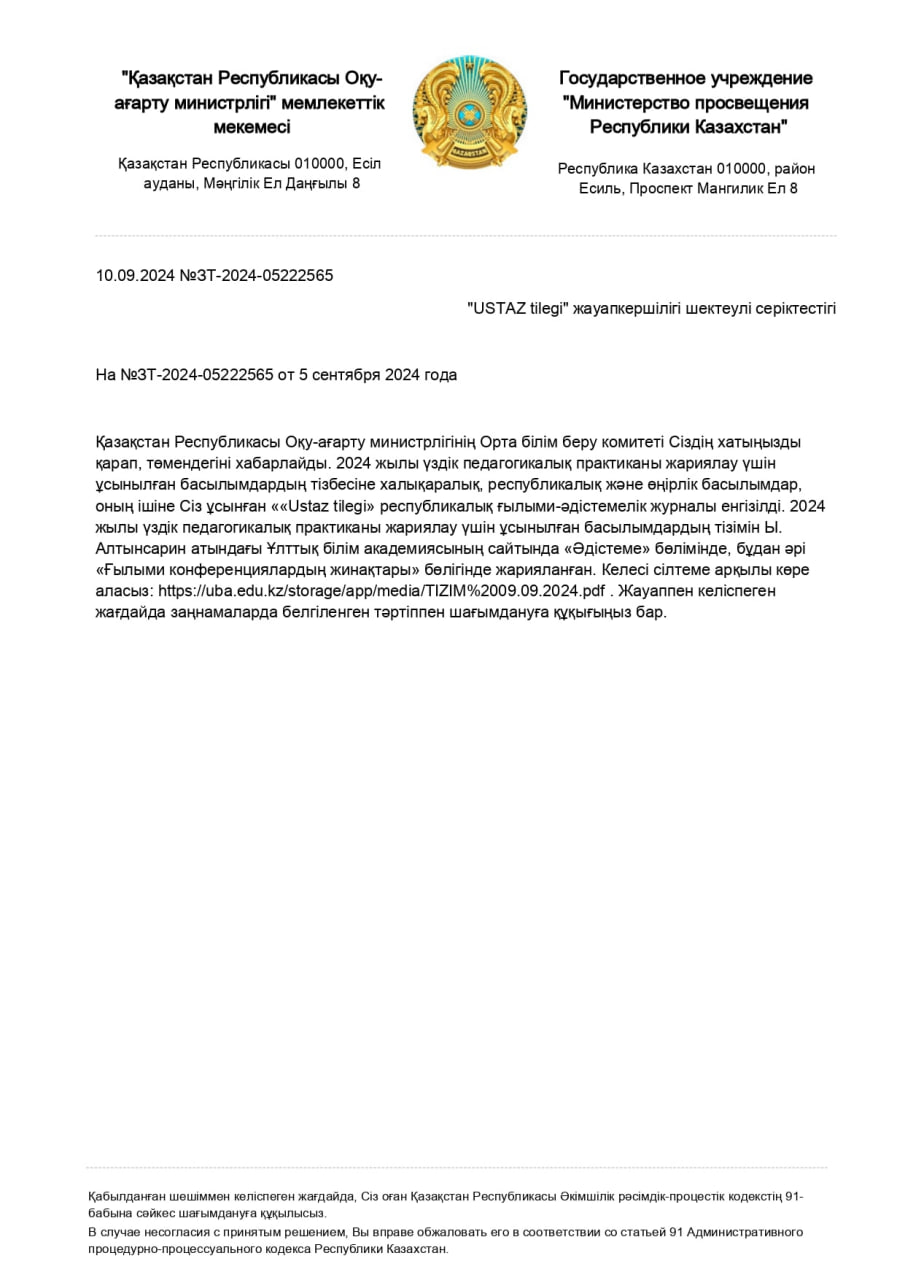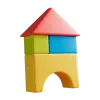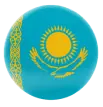ҚАЗАҚСТАН РЕСПУБЛИКАСЫНЫҢ БІЛІМ ЖӘНЕ ҒЫЛЫМ
МИНИСТРЛІГІ
«ТАРАЗ-ҒАСЫР» КОЛЛЕДЖІ
«БЕКІТЕМІН»
директордың
оқу
және жаңа
технология
жөніндегі
орынбасары
Ш.Б.Аширова
___________
«___ »
__________2017ж
Ашық
сабақ
Тақырыбы: Kazakh customs and traditions
of the people.
Оқытушы: Тажиева Мырзагүл
Толебаевна
Пәні: Ағылшын
тілі
Мамандық: 0101000-«Мектепке дейінгі
тәрбие және оқыту»
Курс: I
топ: МД
1-16
Жоспар кафедра
отырысындақарастырылып, ұсынылды.
Хаттама №____ _«__ »
____________________2017
ж
Кафедра меңгерушісі:
_______________________ З.
Матаева
Сабақ
жоспары
Күні: 13.03.17ж.
Пәні: Ағылшын
тілі
Тобы: Мд
1-16
Сабақтың
тақырыбы: Kazakh customs and traditions
of the people.
Сабақтың
түрі: Аралас
сабақ
Сабақтың
мақсаты: Білімгерлерге өз ұлтының салт
дәстүрлері туралы ағылшын тілінде мәлімет беру. Тақырып бойынша
ағылшын тілінде сөйлеуге салт дәстүрлерді үйрену арқылы халқын,
отанын сүюге, ата дәстүрлерін құрмет етуге
баулу.
Сабақта қолданылатын
әдіс-тәсілдер: Сұрақ-жауап, түсінік беру,
дамыта оқыту.
Пәнаралық
байланыс: педагогика, психология,
мәдениеттану, қазақ тілі.
Сабақтың
жабдықталуы: карточкалар,мультимедиалық
проектор, ұлттық киімдер.
Сабақтың
барысы:
І. Ұйымдастыру
кезеңі
Біздің
ұран:
Little strokes fell freat
darks.
ІІ. Үй тапсырмасын
сұрау
Houme
work
The Kazakhs are an extremely
hospitable people.
Traditionally every guest is
offered dishes of national Kazakh cuisine at the dastarkhan (the
low table) in a yurt.
Yurts

The yurt is one of the most
sensible movable house.
It is a comfortable and
practical home, ideally suited to the local conditions and way of
life – one of the greatest inventions of Eurasian
nomads.
It is easily taken apart (it
is said that a Kazakh woman can do it in half an hour) and carried
on horses and camels.
The yurt consists of three
main elements: an extensible trellis base
(the
kerege), a dome made of poles
(the
uyk) and a round top
(the
shanyrak).
The Kazakh national
dress

The Kazakh national dress
varies by regions.
Men wear chapans, a kind of
dressing gown with a belt, made of velvet and richly
embroidered.
They cover their heads with a
soft skullcap (tobetai), a tall felt cap
(kalpak) or a fox-fur hat with
earflaps (malakai).
The women's national costume
consists of a white cotton or colored silk dress, a velvet
waistcoat with embroidery and a cap or a silk
scarf.
Elderly women wear a hood made
of white cloth with a hole for the face
(the
kimeshek). Brides wear a tall pointed,
richly decorated hat, topped with feathers
(saukele).
Music and musical
instruments
The Kazakhs love the art of
words and their akyns (poets), who improvise at public competitions
(aitys) accompanied by national stringed musical instruments:
the dombra or the
kobyz.
National
games
National games: Kazaksha kures
(Kazakh wrestling), baiga (horse racing over 25, 50 or
100 km), kokpar (a sort of polo game played
with a dead goat), kyz-kuu (catch the girl)
and alty
bakan (six-pole
swing).
Kokpar.
This is horseracing struggle,
horsemen struggle for goat taking-over. “Kokpar-kokbori” means the
Kazakh grey wolf. The game has two variants. The most widely used
is “zhalpy-tartys”, when many horsemen take part
in this game and everyone struggles for the animal’s carcass. The
other variant is “Doda
tartys”.

Kyz
kuu.
National horseracing game is
carried out on the racecourse of
hippodrome.
The game distance is 300-400
m.
Two movable flags are set on
the start in 10 meters from each other.
The girl starts at the first
flag.
Crossing of the flags line by
the girl gives the right to dzhigit to catch
her.
The main point of the game is
to catch the girl.
If dzhigit catches the girl,
he becomes the winner and may kiss her.
If the girl catches dzhigit,
she becomes the winner and may hit him by
“kamcha”.


Baiga

Alty
bakan

Nauryz
Nauryz (the Islamic New Year)
is one of the biggest holidays in Central Asia. It is celebrated on
the day of spring equinox of March 22. On that day, the streets of
villages and towns are transformed. Guests are met in beautiful
yurts with the traditional Nauryz kozhe dish made of seven
traditional ingredients.
ІІІ. Жаңа тақырып бойынша
жұмыс:
Kazakh national
traditions
Shildehana is a child’s
birth celebration.
K alzha is ceremonial treating of
parturient woman in the first day of parturition. This is care
about parturient woman and symbol of respect and kindness. This
celebration is made nowadays usually on the 40th day after the
child’s birth. The mother of parturient woman brings sheep, “kalta”
or “korzhyn” with foodstuff and gifts for this
celebration.
alzha is ceremonial treating of
parturient woman in the first day of parturition. This is care
about parturient woman and symbol of respect and kindness. This
celebration is made nowadays usually on the 40th day after the
child’s birth. The mother of parturient woman brings sheep, “kalta”
or “korzhyn” with foodstuff and gifts for this
celebration.
Besikke salu,
besik toy is a holiday arranged
after the child’s putting to cradle (in 3-5 days after umbilical
cord falling off).
Esim koyu, at
koyu is a holiday of name giving to
the child. This holiday is celebrated during “shildehana” or on the
3rd day after the child’s birth a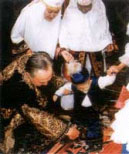 nd child’s putting to cradle (“besik
toy”).
nd child’s putting to cradle (“besik
toy”).
Kyrkynan
shygaru is a holiday, celebrated on
the 40th day after the child’s birth. This is a ceremony of the
child’s bathing in forty-spoons-water, first hair and nails
cutting.
Tusau
kesu are the child’s first
steps.
Lately, this celebration is
committed to the man (usually from relatives), who walks
fast.
Sundetke otyrgyzu
(circumcision). In this day parents of
5-7-year-old son invite venerable mullah, who makes circumcision.
On this occasion, many guests are invited and give presents to the
child and his parents.
2. Wedding customs and
ceremonies.
During marriage, certain
restrictions were observed. Therefore, the girls were married off
in 13-14 years old and boys were married in 14-15 years old.
Nowadays such early marriages are not u sed.
sed.
The whole process of marriage
has several stages and each stage has customs and ceremonies.
During “kudalyk” (matchmaking), the visit of
matchmakers into the bride’s house is made, bride-money to the
bride’s father are given. Ceremonial treating “Kuyrik bauyr” made
from liver and fat tail means matchmaking.
Kyz
uzatu means bride’s
seeing-off.
Five-seven or more matchmakers
arrive in the evening.
The bride leaves home with
matchmakers early in the morning. Girls and dzhigits sing
“Zhar-zhar” song.
Kelin
tusiru is celebration of the
daughter-in-law meeting. People sing traditional song
“Betashar” (song of wishes and
desires). Treating of son-in-law by brisket meat symbolizes wealth,
welfare and fertility.
ІV.
Жаңа тақырыпты
бекіту:
We have many traditions.
Please, who can tell about ….kazakh
traditions?
What is a national
tradition «Suyinshi?»
Suyinshi is a gift for good
news.
What is a national
tradition «Baygazy?»
Baygazy is a gift for new
thing.
What is a national
tradition «Korimdik?»
Korimdik is a gift for bride-show and
bride dowry.
What is a national
tradition «Asar?»
Asar is a tradition of mutual help
of people. Calling of relatives, friends and neighbours for urgent
work that can’t be done by one family. The helpers were tasty
treated.
What is a national
tradition «Erulik?»
Erulik is a treating for new
neighbours. Country people invited new settlers for “erulik” for
their quick adaptation in new environment. This custom is used
nowadays.
What is a national
tradition «Konil
surau?»
Konil
surau means an inquire after smb`s
health. People say: “Recovery of sick is good deed of
healthy”.
Work with
dictionary.
1.Culture
2.Tradition
Now, make up
sentences.
Now, doing exercises. Please
attension!
V.
Студенттерді
бағалау.
VI.
Үй тапсырмасын
беру.
VII.Рефлексия

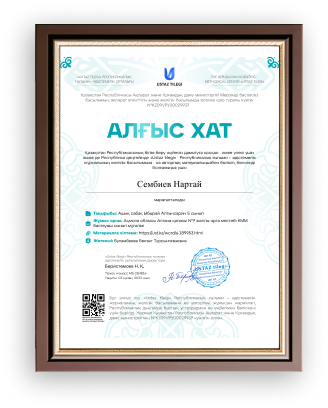











 alzha
alzha nd child’s putting to cradle (“besik
toy”).
nd child’s putting to cradle (“besik
toy”). sed.
sed.